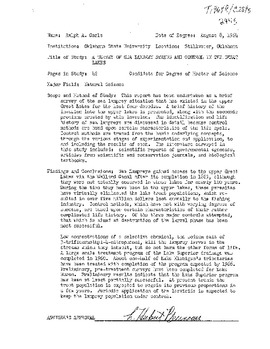| dc.contributor.advisor | Bruneau, L. Herbert | |
| dc.contributor.author | Carls, Ralph A. | |
| dc.date.accessioned | 2016-02-24T21:37:38Z | |
| dc.date.available | 2016-02-24T21:37:38Z | |
| dc.date.issued | 1964-08 | |
| dc.identifier.uri | https://hdl.handle.net/11244/31601 | |
| dc.description.abstract | Scope and Method of Study: This report has been undertaken as a brief survey of the sea lamprey situation that has existed in the upper Great Lakes for the last four decades. A brief history of the invasion into the upper lakes is presented, along with the economic problems created by this invasion. The identification and life history of sea lampreys are discussed in detail because control methods are band upon certain characteristics of the life cycle. Control methods are traced from the basic underlying concepts, through the various stages of experimentation and application, to and including the results of each. The literature surveyed in this study included: scientific reports of governmental agencies, articles from scientific and conservation journals, and biological textbooks. | |
| dc.description.abstract | Findings and Conclusions: Sea Lampreys gained access to the upper Great Lakes via the Welland Canal after its completion in 1829, although they were not actually observed in these lakes for nearly 100 years. During the time they have been in the upper lakes, these parasites have virtually eliminated the lake trout populations, which resulted in over five million dollars lost annually to the fishing industry. Control methods, which have met with varying degrees of success, are based upon certain characteristics of their rather complicated life history. Of the three major controls attempted, that which is aimed at destruction of the larval phase has been most successful. | |
| dc.description.abstract | Low concentrations of a selective chemical, the sodium salt of 3-trifluormethyl-4-nitrophenol, kill the lamprey larvae in the streams which they inhabit, but do not harm the other forms of life. A large scale treatment program of the Lake Superior drainage was completed in 1960. About one-half of Lake Michigan's tributaries have been treated with completion of the program expected by 1966. Preliminary, pre-treatment surveys have been completed for Lake Huron. Preliminary results indicate that the Lake Superior program has been at least partially successful. At present trends the trout population is expected to regain its previous proportions in a few years. Periodic application of the larvicide is expected to keep the lamprey population under control. | |
| dc.format | application/pdf | |
| dc.language | en_US | |
| dc.rights | Copyright is held by the author who has granted the Oklahoma State University Library the non-exclusive right to share this material in its institutional repository. Contact Digital Library Services at lib-dls@okstate.edu or 405-744-9161 for the permission policy on the use, reproduction or distribution of this material. | |
| dc.title | Survey of sea lamprey status and control in the Great Lakes | |
| dc.contributor.committeeMember | Fite, Robert C. | |
| osu.filename | Thesis-1964R-C284s.pdf | |
| osu.accesstype | Open Access | |
| dc.type.genre | Master's Report | |
| dc.type.material | Text | |
| thesis.degree.discipline | Natural Science | |
| thesis.degree.grantor | Oklahoma State University | |
